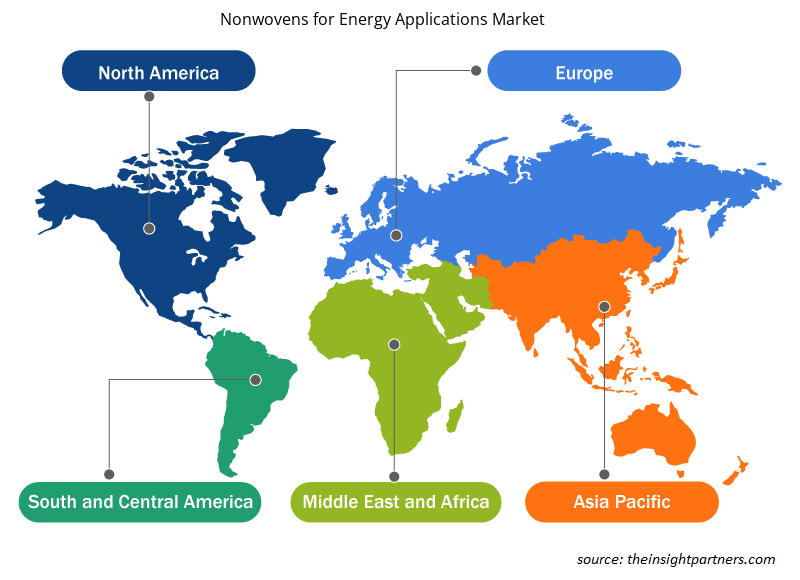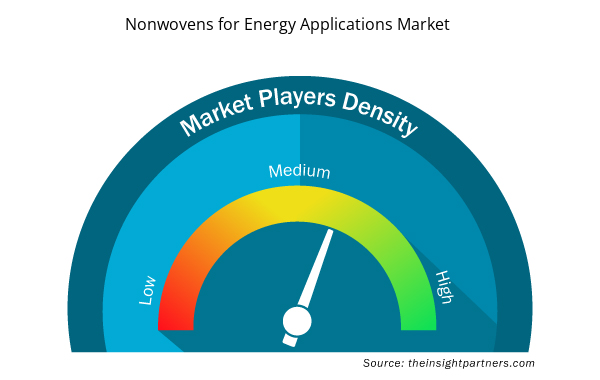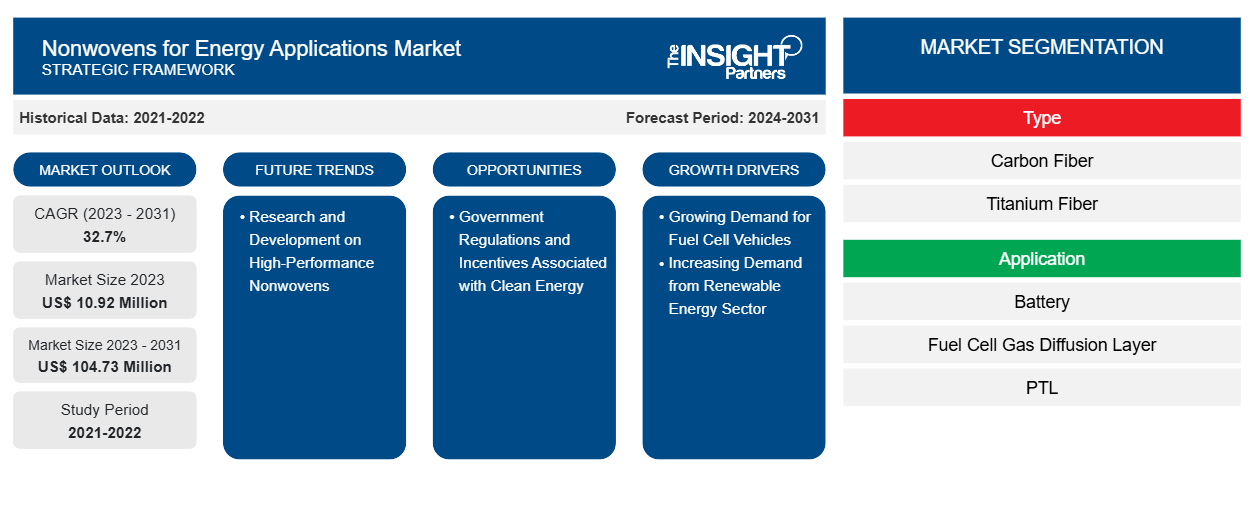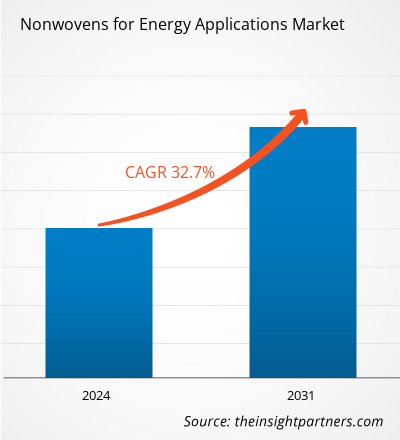エネルギー用途の不織布市場規模は、2023年の1,092万米ドルから2031年には1億473万米ドルに達すると予測されています。市場は2023年から2031年の間に32.7%のCAGRを記録すると予想されています。さまざまな業界の要求の厳しい用途に対応する高性能不織布の研究開発は、エネルギー用途の不織布市場に新たなトレンドをもたらす可能性があります。
エネルギー用途向け不織布市場分析
自動車産業のグリーンで持続可能な技術への移行は、燃料電池車の開発と採用を促進しました。その結果、不織布を含む先進材料の需要が増加しました。水素開発計画に従い、中国は2025年までに5万台の燃料電池車を路上に走らせるという目標を設定しました。2024年7月、米国運輸省は、ゼロエミッション車と低エミッション車を備えた117の公共交通プロジェクトに15億米ドルを提供すると発表しました。不織布は燃料電池システムの重要なコンポーネントであり、性能と効率を高めます。燃料電池では、不織布はガス拡散層、プロトン交換膜、断熱材に使用されます。電界紡糸やナノファイバー製造などの不織布製造技術の進歩により、不織布材料の性能特性が向上しています。
エネルギー用途向け不織布市場の概要
エネルギー用途の不織布市場は、エネルギーシステムの性能、効率、持続可能性を高めるために業界が先進的な材料を求めているため、堅調な成長を遂げています。多用途性、軽量性、カスタマイズ可能な特性で知られる不織布は、バッテリー、燃料電池、風力エネルギーなど、さまざまなエネルギー関連アプリケーションでますます利用されています。エネルギー貯蔵分野では、不織布の炭素繊維材料がバッテリーと燃料電池の性能を高めるために不可欠です。炭素繊維不織布はバッテリーの電極の製造に使用され、その導電性によりエネルギー貯蔵容量と効率が向上します。
要件に合わせてレポートをカスタマイズする
このレポートの一部、国レベルの分析、Excelデータパックなど、あらゆるレポートを無料でカスタマイズできます。また、スタートアップや大学向けのお得なオファーや割引もご利用いただけます。
- このレポートの主要な市場動向を入手してください。この無料サンプルには、市場動向から見積もりや予測に至るまでのデータ分析が含まれます。
エネルギー用途向け不織布市場の推進要因と機会
再生可能エネルギー分野からの需要増加
再生可能エネルギー部門は、気候変動と闘い、エネルギー安全保障を強化するための広範な取り組みにより、急速な成長を遂げています。国際エネルギー機関の2023年報告書によると、世界の再生可能電力容量は今後5年間で増加すると予想されており、そのうち太陽光発電と風力エネルギーは、化石燃料や非化石燃料よりも発電コストが低いため、電力容量の96%を占めています。太陽光発電と風力エネルギーの容量は、2022年と比較して2028年までに2倍になると予測されています。再生可能エネルギー産業の経済的魅力の継続的な成長と、特に中国、米国、欧州連合、インドでの政府の政策支援の増加により、今後数年間で容量の成長が加速すると予想されます。世界風力エネルギー協議会によると、2022年には世界中の電力網に77.6GWの新しい風力発電容量が接続され、総設置風力容量は906GWとなり、2021年と比較して9%の成長を記録しました。
クリーンエネルギーに関する政府の規制とインセンティブ
政府の政策は、水素燃料電池やクリーンエネルギー技術に大きな影響を与えます。これらの政策は、エネルギーシステムの性能と効率を高めるために不可欠な不織布などの先進材料の需要に影響を与えます。世界中のさまざまな国の政府は、炭素排出量を削減するための野心的な目標を設定し、クリーンエネルギー技術の採用を奨励しています。たとえば、EUは2050年までにネットゼロ排出量を達成することを目指しています。このような厳格な排出基準は、効率的なエネルギーシステムの開発を必要とし、水素燃料電池やクリーンエネルギー技術における不織布の需要を押し上げます。いくつかの政府は、再生可能エネルギー源を使用して水を電気分解するグリーン水素生産を促進する戦略も設計しています。2023年12月、エネルギー安全保障長官(英国)は、電気分解によるグリーン水素生産のための11のプロジェクトへの資金提供を発表しました。2024年5月、Hydrogen UkraineとAB5 Consultingは、ウクライナでの再生可能水素プロジェクトの開発に対する助成金を獲得しました。このプロジェクトは、英国国際開発局のInnovate Ukraineを通じて資金提供されました。
エネルギー用途向け不織布市場レポートのセグメンテーション分析
エネルギー用途向け不織布市場分析の導出に貢献した主要セグメントは、タイプとアプリケーションです。
- エネルギー用途の不織布市場は、種類別に、炭素繊維、チタン繊維、その他に分類されます。2023年には炭素繊維セグメントが市場を支配しました。
- 用途別に見ると、市場はバッテリー、燃料電池ガス拡散層(GDL)、PTL、風力エネルギーに分類されます。燃料電池ガス拡散層(GDL)セグメントは、2023年にエネルギー用途向け不織布市場で最大のシェアを占めました。
エネルギー用途向け不織布の地域別市場シェア分析
エネルギー用途向け不織布市場レポートの地理的範囲は、主に北米、アジア太平洋、ヨーロッパ、中東およびアフリカ、南米および中米の 5 つの地域に分かれています。
アジア太平洋地域は2023年に最大の市場シェアを占め、予測期間中に最高のCAGRを記録すると予想されています。バッテリー技術の向上に伴い、アジア太平洋地域は新エネルギー車生産の主要拠点になると予想されています。中国は、電気自動車を推進する政府の政策に支えられ、世界最大の電気自動車市場の1つとして浮上しています。中国自動車工業協会によると、2023年に中国で販売された燃料電池電気自動車は約6,000台で、前年比72%増です。アジア太平洋地域のいくつかの経済圏は、今後数年間でこの地域の燃料電池電気自動車の成長を支援するために、政府に従って新エネルギー車産業を拡大する計画を立てています。2022年に発表された水素開発計画によると、中国は2025年末までに5万台の燃料電池車を路上に走らせるという目標を設定しています。
エネルギー用途向け不織布市場の地域別洞察
予測期間を通じてエネルギー用途向け不織布市場に影響を与える地域的な傾向と要因は、Insight Partners のアナリストによって徹底的に説明されています。このセクションでは、北米、ヨーロッパ、アジア太平洋、中東、アフリカ、南米、中米にわたるエネルギー用途向け不織布市場のセグメントと地域についても説明します。

- エネルギー用途向け不織布市場の地域別データを入手
エネルギー用途向け不織布市場レポートの範囲
| レポート属性 | 詳細 |
|---|---|
| 2023年の市場規模 | 1,092万米ドル |
| 2031年までの市場規模 | 1億473万米ドル |
| 世界のCAGR(2023年~2031年) | 32.7% |
| 履歴データ | 2021-2022 |
| 予測期間 | 2024-2031 |
| 対象セグメント | タイプ別
|
| 対象地域と国 | 北米
|
| 市場リーダーと主要企業プロフィール |
|
市場プレーヤーの密度:ビジネスダイナミクスへの影響を理解する
エネルギー用途向け不織布市場は、消費者の嗜好の変化、技術の進歩、製品の利点に対する認識の高まりなどの要因により、エンドユーザーの需要が高まり、急速に成長しています。需要が高まるにつれて、企業は提供を拡大し、消費者のニーズを満たすために革新し、新たなトレンドを活用し、市場の成長をさらに促進しています。
市場プレーヤー密度とは、特定の市場または業界内で活動している企業または会社の分布を指します。これは、特定の市場スペースに、その規模または総市場価値と比較して、どれだけの競合相手 (市場プレーヤー) が存在するかを示します。
エネルギー用途向け不織布市場で事業を展開している主要企業は次のとおりです。
- テクニカルファイバー製品
- テックステックインダストリーズ株式会社
- フロイデンベルググループ
- SGLカーボンSE
- リダル株式会社
- アステンジョンソン株式会社
免責事項:上記の企業は、特定の順序でランク付けされていません。

- エネルギー用途向け不織布市場のトップキープレーヤーの概要を入手
エネルギー用途向け不織布の市場ニュースと最近の動向
エネルギー用途の不織布市場は、重要な企業出版物、協会データ、データベースを含む一次調査と二次調査後の定性的および定量的データを収集することによって評価されます。エネルギー用途の不織布市場におけるいくつかの開発を以下に示します。
- テクニカル ファイバー プロダクツは、高性能炭素繊維不織布の導入により、バッテリー技術分野における画期的な進歩を発表しました。(出典: James Cropper PLC、企業ニュース、2024 年 7 月)
- 東レ株式会社は、1平方インチあたり1,160キロポンド(Ksi)という世界最高強度を誇るTORAYCA™ T1200炭素繊維の開発を発表しました。この新製品は、炭素繊維強化プラスチック材料の軽量化による環境負荷の削減を同社に促すものとなります。(出典:東レアドバンストコンポジッツ、プレスリリース、2023年10月)
エネルギー用途向け不織布市場レポートのカバー範囲と成果物
「エネルギー用途向け不織布市場規模と予測(2021〜2031年)」レポートでは、以下の分野をカバーする市場の詳細な分析を提供しています。
- エネルギー用途向け不織布の市場規模と、対象範囲に含まれるすべての主要市場セグメントの予測
- エネルギー用途向け不織布市場の動向、および推進要因、制約、主要な機会などの市場動向
- ポーターの5つの力とSWOT分析の詳細
- 主要な市場動向、国の枠組み、主要プレーヤー、規制、最近の市場動向を網羅したエネルギー用途向け不織布市場分析。
- エネルギー用途向け不織布市場における市場集中、ヒートマップ分析、主要プレーヤー、最近の動向を網羅した業界展望と競争分析
- 詳細な企業プロフィール
- 過去2年間の分析、基準年、CAGRによる予測(7年間)
- PEST分析とSWOT分析
- 市場規模価値/数量 - 世界、地域、国
- 業界と競争環境
- Excel データセット



Report Coverage
Revenue forecast, Company Analysis, Industry landscape, Growth factors, and Trends

Segment Covered
This text is related
to segments covered.

Regional Scope
North America, Europe, Asia Pacific, Middle East & Africa, South & Central America

Country Scope
This text is related
to country scope.
よくある質問
The growing demand for fuel cell vehicles and increasing demand from the renewable energy sector are the major factors responsible for the nonwovens for energy applications market growth.
The research and development on high-performance nonwovens is expected to emerge as a future trend in the market.
Technical Fibers Products, Tex Tech Industries Inc, Freudenberg Group, SGL Carbon SE, Lydall Inc, AstenJohnson Inc, Hoftex Group AG, DeatexGroup S.r.l., Sandler AG, and Glatfelter Corporation Sontara are among the leading market players.
The fuel cell gas diffusion layer (GDL) segment dominated the global nonwovens for energy applications market in 2023.
The carbon fiber segment held the largest share of the global nonwovens for energy applications market in 2023.
The market is expected to register a CAGR of 32.7% during 2023–2031.
Trends and growth analysis reports related to Chemicals and Materials : READ MORE..
The List of Companies - Nonwovens for Energy Applications Market
- Technical Fibers Products
- Tex Tech Industries Inc
- Freudenberg Group
- SGL Carbon SE
- Lydall Inc
- AstenJohnson Inc
- Hoftex Group AG
- DeatexGroup S.r.l.
- Sandler AG
- Glatfelter Corporation
The Insight Partners performs research in 4 major stages: Data Collection & Secondary Research, Primary Research, Data Analysis and Data Triangulation & Final Review.
- Data Collection and Secondary Research:
As a market research and consulting firm operating from a decade, we have published and advised several client across the globe. First step for any study will start with an assessment of currently available data and insights from existing reports. Further, historical and current market information is collected from Investor Presentations, Annual Reports, SEC Filings, etc., and other information related to company’s performance and market positioning are gathered from Paid Databases (Factiva, Hoovers, and Reuters) and various other publications available in public domain.
Several associations trade associates, technical forums, institutes, societies and organization are accessed to gain technical as well as market related insights through their publications such as research papers, blogs and press releases related to the studies are referred to get cues about the market. Further, white papers, journals, magazines, and other news articles published in last 3 years are scrutinized and analyzed to understand the current market trends.
- Primary Research:
The primarily interview analysis comprise of data obtained from industry participants interview and answers to survey questions gathered by in-house primary team.
For primary research, interviews are conducted with industry experts/CEOs/Marketing Managers/VPs/Subject Matter Experts from both demand and supply side to get a 360-degree view of the market. The primary team conducts several interviews based on the complexity of the markets to understand the various market trends and dynamics which makes research more credible and precise.
A typical research interview fulfils the following functions:
- Provides first-hand information on the market size, market trends, growth trends, competitive landscape, and outlook
- Validates and strengthens in-house secondary research findings
- Develops the analysis team’s expertise and market understanding
Primary research involves email interactions and telephone interviews for each market, category, segment, and sub-segment across geographies. The participants who typically take part in such a process include, but are not limited to:
- Industry participants: VPs, business development managers, market intelligence managers and national sales managers
- Outside experts: Valuation experts, research analysts and key opinion leaders specializing in the electronics and semiconductor industry.
Below is the breakup of our primary respondents by company, designation, and region:

Once we receive the confirmation from primary research sources or primary respondents, we finalize the base year market estimation and forecast the data as per the macroeconomic and microeconomic factors assessed during data collection.
- Data Analysis:
Once data is validated through both secondary as well as primary respondents, we finalize the market estimations by hypothesis formulation and factor analysis at regional and country level.
- Macro-Economic Factor Analysis:
We analyse macroeconomic indicators such the gross domestic product (GDP), increase in the demand for goods and services across industries, technological advancement, regional economic growth, governmental policies, the influence of COVID-19, PEST analysis, and other aspects. This analysis aids in setting benchmarks for various nations/regions and approximating market splits. Additionally, the general trend of the aforementioned components aid in determining the market's development possibilities.
- Country Level Data:
Various factors that are especially aligned to the country are taken into account to determine the market size for a certain area and country, including the presence of vendors, such as headquarters and offices, the country's GDP, demand patterns, and industry growth. To comprehend the market dynamics for the nation, a number of growth variables, inhibitors, application areas, and current market trends are researched. The aforementioned elements aid in determining the country's overall market's growth potential.
- Company Profile:
The “Table of Contents” is formulated by listing and analyzing more than 25 - 30 companies operating in the market ecosystem across geographies. However, we profile only 10 companies as a standard practice in our syndicate reports. These 10 companies comprise leading, emerging, and regional players. Nonetheless, our analysis is not restricted to the 10 listed companies, we also analyze other companies present in the market to develop a holistic view and understand the prevailing trends. The “Company Profiles” section in the report covers key facts, business description, products & services, financial information, SWOT analysis, and key developments. The financial information presented is extracted from the annual reports and official documents of the publicly listed companies. Upon collecting the information for the sections of respective companies, we verify them via various primary sources and then compile the data in respective company profiles. The company level information helps us in deriving the base number as well as in forecasting the market size.
- Developing Base Number:
Aggregation of sales statistics (2020-2022) and macro-economic factor, and other secondary and primary research insights are utilized to arrive at base number and related market shares for 2022. The data gaps are identified in this step and relevant market data is analyzed, collected from paid primary interviews or databases. On finalizing the base year market size, forecasts are developed on the basis of macro-economic, industry and market growth factors and company level analysis.
- Data Triangulation and Final Review:
The market findings and base year market size calculations are validated from supply as well as demand side. Demand side validations are based on macro-economic factor analysis and benchmarks for respective regions and countries. In case of supply side validations, revenues of major companies are estimated (in case not available) based on industry benchmark, approximate number of employees, product portfolio, and primary interviews revenues are gathered. Further revenue from target product/service segment is assessed to avoid overshooting of market statistics. In case of heavy deviations between supply and demand side values, all thes steps are repeated to achieve synchronization.
We follow an iterative model, wherein we share our research findings with Subject Matter Experts (SME’s) and Key Opinion Leaders (KOLs) until consensus view of the market is not formulated – this model negates any drastic deviation in the opinions of experts. Only validated and universally acceptable research findings are quoted in our reports.
We have important check points that we use to validate our research findings – which we call – data triangulation, where we validate the information, we generate from secondary sources with primary interviews and then we re-validate with our internal data bases and Subject matter experts. This comprehensive model enables us to deliver high quality, reliable data in shortest possible time.


 このレポートの無料サンプルを入手する
このレポートの無料サンプルを入手する